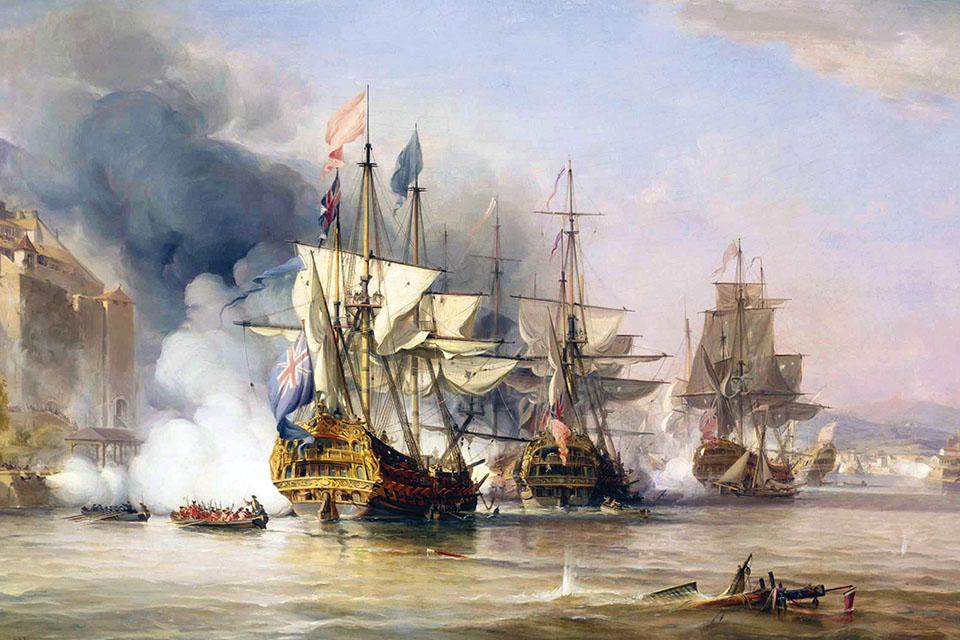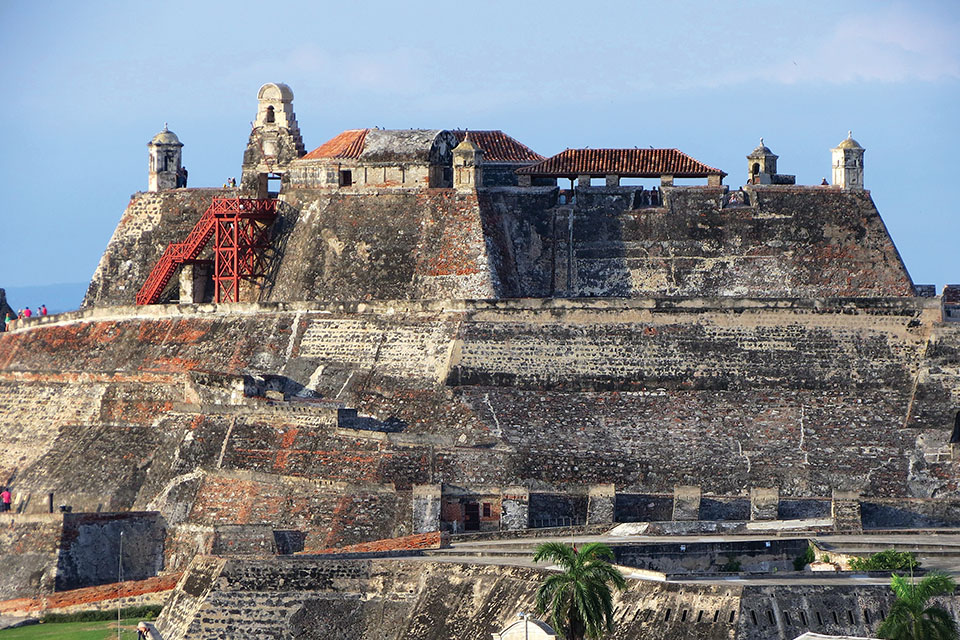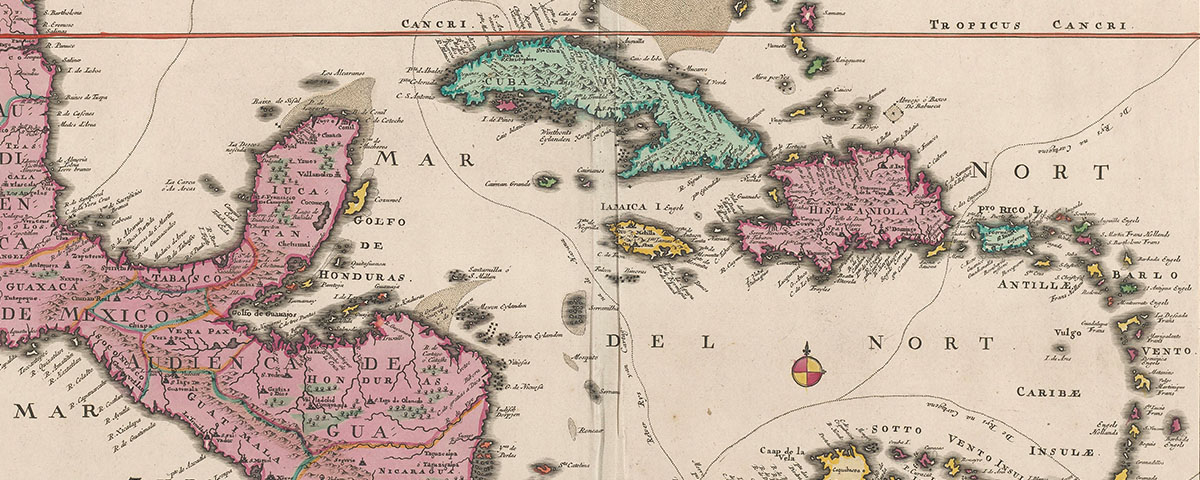In April 1731, offshore from Havana, the Spanish guarda costa vessel Isabella under the command of Captain Juan de León Fandiño stopped the British merchantman Rebecca, ostensibly on suspicion of smuggling. That ship’s irate master, Richard Jenkins, explained that his vessel was returning to Britain after having traded around the Caribbean. Fandiño wasn’t interested in route details; he was after plunder. The Spaniard and crew began to strip Rebecca of its money and cargo. Then, in the words of Rear Admiral Charles Stewart, the British commander of Jamaica Station, in a complaint to the Spanish governor of Havana, “After using the captain [Jenkins] in a most barbarous and inhuman manner…[Fandiño cut] off one of his ears.”
Some years would pass before the British public learned of the atrocity, but by 1731 privateering and outright piracy were common in the Caribbean, and British ships were by no means always the victims. Both sides had committed numerous such transgressions, moving Stewart to observe, “Villainy is inherent to this climate.” However, the removal of Jenkins’ ear was to have consequences far beyond the merely anatomical.
The Caribbean was a hotly contested region in the early 18th century. Britain had colonized a number of smaller islands, as well as Jamaica, which they had seized from the Spanish in 1655. The French, Dutch and Danish also had possessions in the region. For its part, Spain had a closed colonial system, whereby only Spanish ships were allowed unrestricted trade with its colonies.
Then came the 1713 Treaty of Utrecht, which ended the War of the Spanish Succession. Under its terms Britain was permitted a 30-year trading contract, or asiento, granting it the right to send one 500-ton merchantman loaded with duty-free goods to each of the annual trade fairs—at Cartagena (in present-day Colombia), Portobelo (in present-day Panama) and Veracruz (in present-day Mexico)—and to transport up to 4,800 slaves a year into the Spanish colonies. Five hundred tons of goods a year wasn’t much, but the British never took the number seriously. The London-based directors of the public-private South Sea Co. interpreted the asiento as license to open an extensive smuggling trade in the Caribbean, where British goods were in high demand. The Spanish retaliated by licensing private Spanish merchant ships to act as armed guarda costas. Low-level naval guerrilla warfare ensued. Jenkins lost an ear. Men on either side lost their lives.
Behind the illegal trade lay territorial ambitions. The Caribbean was a rich source of valuable commodities—primarily sugar and tobacco—and a prodigious customer for both British manufactured goods and slaves. Agricultural commodities are labor intensive, and slaves were needed to work the fields.
The Caribbean was also difficult to defend. As early as the 1580s English privateer Sir Francis Drake had raided Spanish colonies and taken Spanish ships, and it was costly for Madrid to maintain the large fleet and garrisons necessary to defend its numerous island holdings. It was axiomatic to the British people, and to a lesser degree to their government, that Britain had a great navy more than capable of defeating any two other European fleets combined. As public outrage against Spanish attacks on British merchant ships grew in the mid-1730s, some members of the government agitated for war, suggesting British sea power might even take Cuba and Puerto Rico, thus acquiring some of the richest colonies in the world.

It was in this context word of the brutal removal of Jenkins’ ear resurfaced. It might have been less dramatic had Jenkins simply been shot, but to have one’s ear cut off was a deliberate insult and, oddly, far more enraging. The public demanded war with Spain. Robert Walpole, the Whig prime minister then in the sunset years of his career, opposed war, and in late 1738 he sent delegates to Madrid’s royal palace of El Pardo to negotiate the trade dispute with Spanish authorities. In the resulting accord Spain agreed to compensate Britain for the seizure of British ships and to limit searches of His Majesty King George II’s vessels, while Britain agreed to compensate Spain for the nonpayment of asiento proceeds. The nations also agreed to open talks about the border between Spanish Florida and the newly founded British colony of Georgia.
The parties signed the accord on Jan. 14, 1739. The incensed British public remained implacable, however, some accusing Walpole of being in Spain’s pay. The directors of the South Sea Co. were also exceedingly displeased. Smuggling had proven almost as profitable as legal trade, and they wanted war as much as the public did. A rumor circulated Jenkins had been ordered to the floor of Parliament to relate his gruesome tale—and to bring his ear, which, it was said, he kept pickled in a jar. No evidence supports the story. Regardless, the clamor continued and intensified, and that October the Crown declared war on Spain.
At the time of Britain’s declaration of war Vice Adm. Edward Vernon and six Royal Navy ships of the line from Jamaica Station were already en route to attack and plunder Portobelo, the chief shipping point for Peruvian silver bound for Spain. Over the decades the port had been a favorite target of privateers and pirates. English privateer William Parker captured it in 1601, Welshman Henry Morgan helped himself to its treasures in 1668, and in 1680 the notorious freebooter John Coxon repeated the deed.
Vernon was known to the Admiralty as a cantankerous, difficult man, but he was also a skilled maritime tactician and captured Portobelo on November 22 after a daylong fight. The British public thrilled at news of the victory and upheld Vernon as the war’s first hero. (George Washington’s eldest half-brother, Lawrence, later served under the admiral during the war, and it was he who named the Washington family estate on the Potomac River after Vernon.)
Three weeks later the British fleet withdrew, leaving the Spanish once again in control. However, Vernon had destroyed Portobelo’s key fortifications, ending its role as a primary maritime base. The admiral had had no intention of permanently garrisoning the port. And that was the key to waging maritime war in the Caribbean: Maintaining control of one’s holdings depended on strong fortifications manned by permanent garrisons. Pirate raids had always been just that—raids, with plunder as their only goal. The same held for raids by privateers officially sanctioned by the Crown; their goal was to capture enemy ships and cargo and bring them home to sell, a portion of the proceeds going to the Crown, the remainder to the respective privateer. Men became rich this way.
In the fall of 1740 the Admiralty sent a squadron of six warships under Commodore George Anson around Cape Horn to harass Spanish possessions and shipping along the west coast of South America. The expedition started rather inauspiciously. Two of Anson’s warships soon retreated around the cape and returned to Britain, one was wrecked along the Chilean coast, another was burned to prevent capture and the storm-damaged fifth and smallest ship was allowed to sink. Anson had lost well over half his crews to scurvy by the time he crossed the Pacific and arrived off the Philippines. Only Centurion, the fourth-rate flagship, remained in the hunt. Finally, on April 19, 1743, the commodore encountered a true prize—Nuestra Señora de Covadonga, a Spanish treasure galleon sailing between Manila and Acapulco. After taking it, Anson returned to Britain by sailing west, circumnavigating the globe and arriving home battered but triumphant in June 1744. Covadonga’s cargo amounted to 1.3 million Spanish pieces of eight and more than 35,000 ounces of silver. The average seaman walked away with the equivalent of 20 years’ wages, while Anson’s share made him one of the richest men in Britain.
While Anson’s voyage proved spectacularly lucrative, it gained Britain no additional land for sugar plantations nor further dominance of maritime trade in the Caribbean. At the time Spain boasted four main ports in the region—Havana (which maintained a dry dock and other ship repair and maintenance facilities), Vera Cruz; Portobelo and Cartagena. Havana was the most heavily defended of the four. Vernon had attempted a raid on Cartagena earlier in his career and failed. But as the port lay to windward of British bases and along the regular trade route of the Spanish treasure galleons, he selected it as Britain’s next target. But contrary to Vernon’s wishes, this action was to be much more than a smash-and-grab raid; an army would be embarked aboard the admiral’s ships.
There were innumerable delays. The Royal Navy would be sending 29 heavily armed ships of the line, 22 frigates, 71 sloops of war, two hospital ships, fireships, bombships (carrying mortars designed to destroy fortress walls), 80 troopships and 50 merchant ships (mostly toting provisions and supplies). Forty additional troopships would transport some 3,600 American colonial troops from New York to the staging area at Jamaica Station. All told, the invasion force comprised more than 27,000 troops and 2,000 cannons.
While impressive, the armada proved a nightmare for the Royal Navy. The service simply did not have enough sailors to man so many ships at one time. Recruiting them, even impressing them—pulling men from taverns, grabbing them off the streets—took months. The Admiralty resorted to supplementing crew shortfalls with ground troops. It took even longer to outfit and prepare the ships. Making matters worse, German-born George II was reluctant to release land troops to any expedition except on the Continent in defense of his native Hanover.
The Royal Navy had other responsibilities to consider—foremost the defense of Britain, which meant maintaining a sufficiently large force in the English Channel to counter any French invasion attempt. This was not just a phantom issue. France was ruled by Bourbon King Louis XV, and the house of Bourbon, in the person of Philip V, also ruled Spain. France had yet to enter the war on Spain’s side, but it seemed poised to, and its formidable navy posed a genuine threat. Another factor was a dearth of effective leadership in the Royal Navy of the era—a problem known to those in the government, though certainly not to the public.
When the invasion force was finally ready, the winds proved contrary. Fully loaded ships idled in port for weeks at a time, the embarked troops eating through their provisions. Though planning for the invasion had begun early in 1740, not until January 1741 did the armada sail from Britain. In the meantime, both Lord Cathcart, commander in chief of all ground forces, and Alexander Spotswood, his second in command, died. Replacing Cathcart was Col. Thomas Wentworth, who had no combat command experience. Morale was low. Scores of men had died of typhus, scurvy and other diseases contracted aboard the tightly crowded ships, and Vernon and Wentworth were increasingly at odds with one another.
In mid-March the fleet finally arrived off Cartagena. The only deep-draft channel into the harbor was so narrow that only one ship of the line at a time could get through, and gun-bearing bastions dominated both flanking peninsulas. The city walls mounted 160 cannons, outlying areas some 120 guns. Spanish defenders numbered between 4,000 and 6,000. The British had assumed Cartagena would be a pushover. It was not.
Wentworth had no sooner landed his troops and cannons when one of history’s small ironies set to work. From the outset of the Age of Discovery pandemics of such European diseases as smallpox and measles had decimated indigenous populations throughout the Americas. Now, even as Wentworth successfully cleared Cartagena’s outlying fortresses, he lost twice as many men to yellow fever and malaria as to combat. In May the rainy season began, exacerbating the situation.
Despite the challenges posed by geography, disease and the weather, the British continued to make steady progress, eventually capturing all but one of Cartagena’s forts. The final bastion, San Lazaro, overlooked the city and the harbor, and Spanish forces withdrew within its walls, determined to hold out until the rainy season exposed British land forces to impossible living conditions and those at sea to stifling confinement—in short, to the steady attrition of discomfort, disease and dwindling supplies. Vernon and Wentworth went from being at odds to no longer speaking.
When the expedition’s only artillery engineer was killed in action, the British were unable to establish a battery with which to breach San Lazaro. In a last-ditch attempt Wentworth decided to launch a nighttime infantry attack on the fort, using ladders to scale its intact walls. Spanish deserters would lead the British vanguard—a 50-man forlorn hope backed by 450 grenadiers—to the lowest, most vulnerable walls, followed by the main body of 1,000 men. Unarmed Americans carried the scaling ladders and wool packs with which to fill the trenches. But the assault stepped off too close to dawn, exposing the advance troops to deadly fusillades, while the Spanish deserters led the British to the highest, not lowest, of the walls. Any assault ladders deployed fell 10 feet too short. The attack never had a chance. Fort San Lazaro remained in Spanish hands, as did Cartagena.
In their reports to London, Vernon and Wentworth blamed one another for the failed 67-day campaign, but the deciding factor had been viral in origin. During preparations for the attack on San Lazaro, Wentworth’s land forces numbered some 6,500 relatively healthy men. By the time the battle was over, that number had been halved, most lost to disease. On the fleet’s return to Jamaica Station only about 1,400 British and 1,300 American troops remained effective. At Wentworth’s request the government had already sent reinforcements, but the Crown recalled them when news of the defeat reached London. By then much of Europe was embroiled in the War of the Austrian Succession, which through 1748 locked Britain, France, Spain, Prussia, the Netherlands, the Holy Roman empire (including George II’s beloved Hanover) and their respective allies in a land and sea war. The Caribbean returned to the status quo, with further talk about but no action toward capturing a major Spanish port.

The 1748 Treaty of Aix-la-Chapelle formally ended both the War of the Austrian Succession and the War of Jenkins’ Ear. Little changed in the Caribbean. The main outcome in Europe was that Silesia, an Austrian possession, passed to Prussia. Nothing in the treaty resolved ongoing disputes or prevented further conflict, and within a decade the Seven Years’ War broke out—much of it fought between Britain and France on American soil. Some historians have dubbed it “World War Zero,” as it also spread to India. The issues are always similar—power, money, glory. And territory. The Earth, apparently, is just not big enough for humanity. People always want more.
A frequent contributor to Military History, Anthony Brandt is the author of The Man Who Ate His Boots: The Tragic History of the Search for the Northwest Passage (2010). For further reading he recommends The Emergence of Britain’s Global Naval Supremacy and Seapower and Naval Warfare, 1650–1830, both by Richard Harding, and Britannia’s Glories, by Philip Woodfine.

